|
|
Booklets
|
Methodologies expressed in a popular language for the adoption of new technologies
|
|
|
 |
|
Canavalia brasiliensis |
|
Institution/Author:
Douxchamps, S.; Mena, M.; Van der Hoek, R.; Benavides, A.; Schmidt, A. (eds.) |
|
Publisher:
CIAT |
|
Year:
2011 |
|
El aumento de la población de Centroamérica ha requerido el uso de más tierras destinadas a cultivos para tratar de satisfacer la demanda creciente de alimentos. Sin embargo, diversas razones obligan a los pequeños y medianos productores a un uso intensivo permanente del suelo, utilizando incluso areas de ladera, más vulnerables a la erosión, o suelos poco fértiles, con prácticas inapropiadas. Canavalia brasiliensis es una leguminosa herbácea multipropósito que puede ser utilizada como abono verde para mejorar la fertilidad del suelo o como forraje para aumentar la producción de leche en verano, aumentando así la productividad de los sistemas. |
|
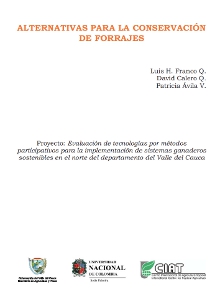 |
|
Alternativas para la conservacion de Forrajes |
|
Institution/Author:
Luis H. Franco Q.; David Calero Q.; Patricia Ávila V. |
|
Publisher:
CIAT |
|
Year:
2007 |
|
Esta cartilla, es un complemento del curso de capacitación desarrollado para los productores beneficiarios del proyecto, sobre alternativas de conservación de forrajes y describe los métodos de conservación y preparación de henos y ensilajes a mediana y pequeña escala, además de servir como documento de consulta, cuando el ganadero decida iniciar un proceso de conservación de nuevas especies forrajeras tropicales multipropósito en su sistema. |
|
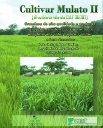 |
|
Cultivar Mulato II (Brachiaria Hybrid CIAT 36087): A High-Quality Forage Grass, Resistant to Spittlebugs and Adapted to Well-Drained, Acid Tropical Soils |
|
Institution/Author:
ARGEL, P.J.; MILES, J.W.; GUIOT, J.D.; CUADRADO, H.; LASCANO, C.E. |
|
Publisher:
CIAT |
|
Year:
2007 |
|
This brochure presents the findings of ongoing or completed agronomic adaptation and animal production studies conducted with Mulato II in the tropical lowlands of China, Thailand, Mexico, Colombia, Venezuela, Bolivia, Uruguay, Brazil, and several Central American countries, particularly Panama. 21 p. 16.5 x 24 cm. Also available in Spanish and Portuguese. |
|
 |
|
Segundo Taller Taninos en la Nutrición de Rumiantes en Colombia |
|
Institution/Author:
Hans-Dieter Hess; Julia Gómez; Carlos E. Lascano |
|
Publisher:
CIAT |
|
Year:
2006 |
|
1. Taninos. 2. Leguminosas forrajeras. 3. Plantas de ramoneo. 4. Nutrición animal. 5. Rumiante. 6. Ganado bovino. 7.Ovinos. 8. Calliandra calothyrsus. 9. Cratylia. 10. Flemingia macrophylla. 11. Leucaena leucocephala. 12. Desmodium ovalifolium. 13. Vigna unguiculata. 14. Digestión ruminal. 15. Fermentación. 16. Polifenoles. 17. Digestibilidad. 18. Proteínas. 19. Colombia |
|
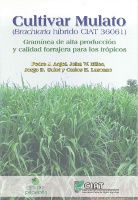 |
|
Cultivar Mulato (Brachiaria híbrido CIAT 36061) Gramínea de alta producción y calidad forrajera para los trópicos. |
|
Institution/Author:
Pedro J. Angel; John W. Miles; Jorge D. Guiot; Carlos E. Lascano |
|
Publisher:
CIAT |
|
Year:
2005 |
|
El Brachiaria híbrido cultivar (cv.) Mulato (CIAT 36061) es el primer híbrido comercial obtenido por el proyecto de Forrajes Tropicales del CIAT, el cual se originó de cruces realizados a partir de 1988 en la sede principal en Cali, Colombia, entre el clon sexual tetraploidizado 44-6 de B. ruziziensis y la especie tetraploide B. brizantha CIAT 6294(=CIAT 6780). que corresponde al cv. Marandu en Brasil, cv. Insurgente en México y al cv. Diamantes 1 en Costa Rica. |
|
 |
|
Taninos en la Nutrición de Rumiantes en Colombia |
|
Institution/Author:
Hans-Dieter Hess; Julia Gómez |
|
Publisher:
CIAT |
|
Year:
2004 |
|
Memorias del Taller sobre taninos realizado el 18 de mayo 2004. Objetivo Principal: Resumir el estado de arte de la utilización de especies forrajeras ricas en taninos en la nutrición de rumiantes en Colombia. |
|
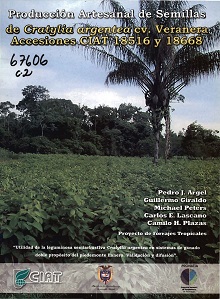 |
|
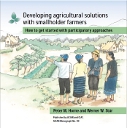 |
|
Developing Agricultural Solutions with Smallholder Farmers: How to Get Started with Participatory Approaches |
|
Institution/Author:
HORNE, P.M.; STUR, W.W. |
|
Publisher:
CIAT |
|
Year:
2003 |
|
Agricultural development workers can take advantage of farmers being natural experimenters, that is, always trying out new ideas and technologies to improve their farming practices. By adopting participatory approaches in their research and extension work, development workers can help small farmers living in remote areas tackle the issues involved in low-input, upland production systems. The booklet provides starting points in terms of ideas, practical tips, and basic tools. The booklet is a new title in the CIAT in Asia Research for Development Series. Other titles available in this series are: "How to Select the Best Varieties to Offer Farmers in Southeast Asia", and "How to Grow, Manage, and Use Forages". All language versions of the books (currently English, Indonesian, Lao Thai, Chinese, Vietnamese and soon to include Burmese and Khmer) are available from the CIAT office in Vientiane. |
|
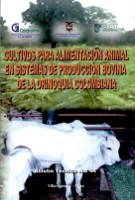 |
|
Cultivos para la alimentación animal en sistemas de producción bovina de la orinoquia Colombiana |
|
Institution/Author:
Corpoica; CIAT |
|
Publisher:
CIAT |
|
Year:
2003 |
|
Para mantener la disponibilidad de carne y leche de mejor calidad durante todo el año se requiere que el productor mejore la productividad de la empresa, a través del uso de tecnología sobre producción y utilización estratégica de forrajes conservados. Esta publicación fue posible gracias a los recursos de cofinanciación del Ministerio de Agricultura y Desarrollo Rural de Colombia, ejecutados por Corpoica a través del convenio No.071 entre el Ministerio de Agricultura - CIAT - CORPOICA. |
|
 |
|
 |
|
Producción Artesanal de Semillas de Pasto Toledo |
|
Institution/Author:
ARGEL, P.J; GIRALDO, G.; PETERS, M.; LASCANO, C.E. |
|
Publisher:
CIAT |
|
Year:
2002 |
|
[Artisanal Seed Production of Toledo Grass (Brachiaria brizantha) CIAT 26110] CIAT's Tropical Forage Project, together with several national research institutions, development projects and Non Governmental Organizations in Costa Rica and Colombia, is promoting Toledo grass (Brachiaria brizantha CIAT 26110). The good acceptance of Toledo in the region has translated into a high demand for seed. This handbook describes the experiences of technicians and of small- and medium-scale producers in Central America, and indicates the minimum management conditions necessary for artisanal seed production. The publication was developed under the project "Farmer Participatory Research in Action: Selection and Strategic Use of Multipurpose Forage Germplasm by Smallholders in Production Systems in Hillsides of Central America", financed by BMZ/GTZ. |
|
 |
|
Producción Artesanal de Semillas de Cratylia |
|
Institution/Author:
ARGEL, P.J; GIRALDO, G.; PETERS, M.; LASCANO, C.E. |
|
Publisher:
CIAT |
|
Year:
2002 |
|
[Artisanal Seed Production of Cratylia (Cratylia argentea) accessions CIAT 18516 and 18668] Recent studies carried out by CIAT's Tropical Forages Project, together with national research institutions in South America, Central America, and the Caribbean, have demonstrated the high potential of the shrub legume Cratylia (Cratylia argentea) in animal production systems. This handbook describes practices for the artisanal seed production of Cratylia to promote its use by small- and medium-scale livestock producers in those areas where drought is a limiting factor. The publication was developed under the project " Farmer Participatory Research in Action: Selection and Strategic Use of Multipurpose Forage Germplasm by Smallholders in Production Systems in Hillsides of Central America", financed by BMZ/GTZ. |
|
 |
|
Pasto Toledo (Brachiaria brizantha CIAT 26110) Gramínea de Crecimiento Vigoroso para Intensificar la Ganadería |
|
Institution/Author:
C. LASCANO-CIAT; PEREZ-CORPOICA; C. PLAZAS-CIAT; J. MEDRANO-CORPOICA; O. PEREZ-CORPOICA Y P.J. ARGEL-CIAT |
|
Publisher:
CIAT |
|
Year:
2002 |
|
Toledo is a new forage alternative directly derived from Brachiaria brizantha accession CIAT 26110. In Colombia, this grass adapts well to sites with soils of intermediate-to-high fertility and annual precipitation above 1600 mm. Its annual forage yields are high during both dry and rainy seasons, allowing stocking rates above 2.5 AU/hectare and milk yields of up to 8.5 kg/cow per day, with Holstein x Zebu cows. |
|
 |
|
Cultivar Veranera (Cratylia argéntea (Desvaux) O. Kuntze): Leguminosa Arbustiva de Usos Múltiples para Zonas.. |
|
Institution/Author:
LASCANO, C.; RINCON, A.; PLAZAS, C.; AVILA, P.; BUENO, G.;ARGEL, P.J. |
|
Publisher:
CIAT |
|
Year:
2002 |
|
[Cultivar Veranera (Cratylia argentea (Desvaux) O. Kuntze): A multi-purpose shrub legume for areas with prolonged periods of drought in Colombia] Cultivar Veranera, Cratylia argentea CIAT 18516, is a shrub legume with great potential to improve animal production systems, especially in the subhumid tropics. Its forage yield is higher than that of herbaceous legumes and it offers good quality forage at sites with prolonged droughts, making it possible to replace energy and protein sources used to manufacture feed concentrates, such as maize and soybean, that are usually beyond the producers' reach. |
|
 |
|
Cultivar Maquenque |
|
Institution/Author:
PEREZ, R.; RINCON, A.; CIPAGAUTA, M.; SCHMIDT, A.; PLAZAS, C.; LASCANO, C. |
|
Publisher:
CIAT |
|
Year:
2002 |
|
[Maquenque: Desmodium Heterocarpon (L.) Dc. Subsp. Ovalifolium (Prain.) Ohashi (Ciat Accession 13651): Multipurpose Legume For Use In Agricultural Production Systems In Colombia] Cultivar Maquenque is a low-cost legume that can be used to recover degraded pastures and as soil cover in perennial plantation crops, such as rubber and palm. It adapts well to a broad range of sites located between 0 and 1300 masl, has high biomass production, and grows well in association with improved grasses. Toledo's excellent biomass production, Veranera?s high protein content, resistance to long periods of drought, and potential use as supplement, and Maquenque?s potential to improve soil quality, control erosion, and suppress weeds are all agronomic characteristics that will hopefully improve the performance and profitability of agricultural and livestock production systems in Colombia. |
|
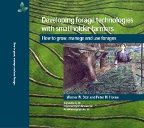 |
|
Developing Forage Technologies with Smallholder Farmers: How to Grow, Manage and Use Forages |
|
Institution/Author:
STUR, W.W.; HORNE, P.M. |
|
Publisher:
CIAT |
|
Year:
2001 |
|
Smallholder farmers traditionally feed their animals on otherwise valueless but freely available feed resources such as crop residues, grasses, herbs, and leaves. However, livestock numbers and cropping areas have increased, limiting the availability of these once-abundant resources and obliging farmers to travel farther to graze their animals or cut feed. Many farmers must now decide between keeping fewer animals or finding new feed resources. Supplementing traditional feed by planting forages is one simple solution. However, for most farmers, planting forages for their animals is a new, untried, concept that must be tested first by planting forages in small plots near their houses. Only when they see benefits will farmers expand planting areas or integrate forages with other cropping and farming activities. This book provides basic information about how to grow, manage, and use forages on smallholder farms in Southeast Asia. It follows on from a previous book in this series ("Developing forages with smallholder farmers: How to select the best varieties to offer farmers in Southeast Asia") which provided information about forage varieties that can grow in a wide range of conditions and either are being used successfully by smallholder farmers or have significant potential in Southeast Asia. All language versions of the books (currently English, Indonesian, Lao Thai, Chinese, Vietnamese and soon to include Burmese and Khmer) are available from the CIAT office in Vientiane. |
|
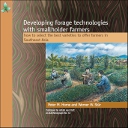 |
|
Developing Forages Technologies with Smallholder Farmers: How to Select the Best Varieties to Offer Farmers in Southeast Asia |
|
Institution/Author:
HORNE, P.M.; STUR, W.W. |
|
Publisher:
CIAT |
|
Year:
1999 |
|
Livestock are an important component of upland farming systems in Southeast Asia. In the past, feed resources were plentiful. On many farms this is no longer the case, so farmers have to spend more and more time finding feed for their animals. Planting forages can help to overcome this problem. However, no two farms have the same resources and needs. Forages that are suitable on one farm may not be suitable for other farms. The best way to develop the best forage technologies for each farm is for farmers to evaluate the most promising options and adapt the best of these to their situations. This booklet does contains information about forages that can grow in a wide range of conditions and either are being used successfully by smallholder farmers or have significant potential in Southeast Asia. Details on managing and using these species can be found in the second booklet of this series: "Developing forages with smallholder farmers: How to grow, manage and use forages". All language versions of the books (currently English, Indonesian, Lao Thai, Chinese, Vietnamese and soon to include Burmese and Khmer) are available from the CIAT office in Vientiane. Individuals and organizations from both developing and developed countries may request a free hardcopy of the book. Orders for multiple copies are sold at US$5 per copy (which includes postage). |
|
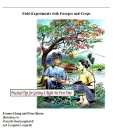 |
|
Field Experiments with Forages and Crops: Practical Tips for Getting it Right the First Time |
|
Institution/Author:
CHENG, Y.; HORNE, P. |
|
Publisher:
CIAT |
|
Year:
1997 |
|
Small farmers in developing countries frequently use a new technology, be it fodder grass, upland rice variety, or crop management practice, in ways that agricultural researchers do not expect. To actively involve farmers in developing and evaluating new technologies, researchers conduct field experiments on farms, frequently in remote places. Because farmers and field workers have little experience in running formal experiments, problems arise, not necessarily from poor experimental design, but from overlooking simple, important procedures like failing to prevent livestock from eating test plants or neglecting to label plots. This guide provides practical tips, using forages as examples, for researchers, field workers, and students on how to avoid these common mistakes. The principles involved can also be applied to most crop plants. This first edition, published in both English and Lao, was compiled by the FSP and the Lao Department of Livestock and Fisheries, with the collaboration of researchers and field workers throughout Southeast Asia, CSIRO, and AusAID-Lao PDR. The ACIAR provided funds for publication and distribution. |
|
 |
|
Maní Forrajero Perenne (Arachis pintoi Krapovickas y Gregory) Una alternativa para Ganaderos y Agricultores |
|
Institution/Author:
RINCON, A.; CUESTA, P.; PEREZ, R.; LASCANO, C.; FERGSON, J. |
|
Publisher:
CIAT |
|
Year:
|
|
En este boletín se describe el Maní Forrajero Perenne (A. pintoi). Se pueden destacar de él algunas características importantes, tales como su buena adaptación a suelos ácidos de baja fertilidad, su compactibilidad con gramíneas del género Brachiaria, su persistencia bajo pastoreo, su buen comportamiento como leguminosa de cobertura en cultivos perennes, su alto valor nutritivo y su consumo por los animales. |
|
 |
|
|
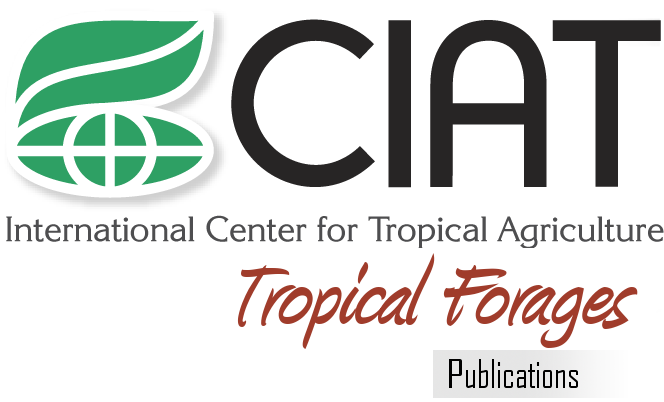
 Contact
Contact


















